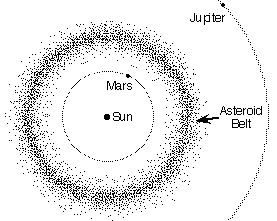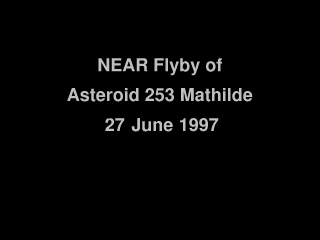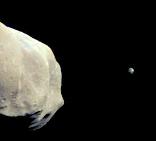 In 1801, the first asteroid, Ceres, about 1000km
in diameter, was discovered. At the time
it was thought to be a small planet. A few years later, three more
asteroids , all about 400-500 km in diameter, were found,
Pallas, Vesta and Juno. By 1900, several
hundred had been identified. Today, several hundred thousand
asteroids have been discovered, all less than 340 km in diameter.
Most are just tens of km in diameter and perhaps a million
1 km asteroids exist.
In 1801, the first asteroid, Ceres, about 1000km
in diameter, was discovered. At the time
it was thought to be a small planet. A few years later, three more
asteroids , all about 400-500 km in diameter, were found,
Pallas, Vesta and Juno. By 1900, several
hundred had been identified. Today, several hundred thousand
asteroids have been discovered, all less than 340 km in diameter.
Most are just tens of km in diameter and perhaps a million
1 km asteroids exist.
All but the largest asteroids are irregular in shape. For an object to become round, they must posses significant self-gravity to overcome the rock strength and pull themselves into a sphere. Asteroids show evidence of collisions: irregular shapes, craters, fragments. These collisions fill the inner solar system full of small asteroid debris (meteoroids) that later become meteorites on earth.
 Location of the Asteroids
Location of the Asteroids
Most lie within the asteroid belt, but over 1000
asteroids > 1 km in diameter have
orbits close to Earth's orbit. An
impact by such an asteroid would have catastrophic effects
on Earth.
Where did the Asteroids come from?
Asteroids are made of material that
was never able to coalesce into a
planet because of Jupiter's gravitational
influence. This theory is supported by chemical
variation seen in the asteroids:
carbonaceous asteroids are preferentially found
further from the sun where heating is less.
If all asteroids was gathered into
a single object, the object would be less
than 1,500 kilometers (932 miles) across,
less than half our Moon's diameter!
Asteroids are fragments of planetesimals. The largest asteroids were large enough to develop molten cores and differentiate. Lava flows may even have happened on their surfaces. 4.5 billions years of evolution, mostly collisions breaking up the pieces smaller, have given us the asteroid belt we see today. Asteroid densities found are surprisingly low, only about 1.3x water. Asteroids are made entirely of rock. The low density indicates they must be made up of a collection of fragments, held together by mutual gravity.

 Close up views of a few asteroids
Close up views of a few asteroids
On June 27, 1997 the spacecraft NEAR made a high-speed close
encounter with asteroid Mathilde. This encounter gave
scientists the first close-up view of an asteroid. This
movie (left) was created from that fly-by encounter.
On its way to Jupiter, the Galileo spacecraft flew through the asteroid belt getting several close up pictures. To the right is an image of asteroid Ida, which was discovered to have a small moon! (click on image). The moon has since been named Dactyl.